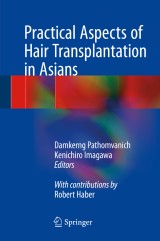Details

Practical Aspects of Hair Transplantation in Asians
|
192,59 € |
|
| Verlag: | Springer |
| Format: | |
| Veröffentl.: | 08.05.2018 |
| ISBN/EAN: | 9784431565475 |
| Sprache: | englisch |
Dieses eBook enthält ein Wasserzeichen.
Beschreibungen
<p>This book comprehensively discusses the practical aspects of hair transplantation in Asians. The demand for hair transplantation has increased globally in recent years and Follicular Unit Extraction (FUE) is gaining popularity. As such the book examines the techniques used by different ethnic group in Asia, included shaving, non-shaving FUE and robotic hair restoration surgery. With the help of illustrations, it describes surgical techniques and provides numerous practical tips. Written by leading experts and offering an overview of the current state of the art of hair restoration surgery, it enables experienced surgeons in the field to achieve optimal outcomes and to improve patients' QOL. It is a must read for hair surgeons performing hair transplantation on members of the Asian population.</p>
Part 1. Anatomy and Biology.- <div>1. The Asian Continent: Its Origin and Evolution.- </div><div>2. Practical anatomy in hair transplantation.- </div><div>3. Hair Characteristics of East and Southeast Asians.- </div><div>4. Hair characteristics of South Asians.- </div><div>5. Hair characteristics of West Asians.- </div>6. Diseases of the hair and scalp in Asians that are of interest to hair surgeons.-<div>7. Differential diagnosis of male and female pattern hair loss.- </div><div>8. Stem cell: Current and Future State.- </div><div>9. Autologous Platelet-Rich Plasma Injection Therapy .- </div><div>10.Holding Solutions, Conditions, and Additives to Optimize Hair Follicle Viability and Function.- </div><div>Part 2. Instrument.-</div><div>11. Dermoscopy.- </div><div>Part 3. Different hairline in Asians.-<br/></div><div>12.Hairline design in South Asians.- </div><div>13.Hairline design in West Asians.- </div><div>14.Naturally occurring hairlines in non-balding oriental men of East and South-East Asian origin.- </div><div>15.Hairline design in East and South East Asians (ESEA).- </div><div>Part 4. Pre and post operative care.-<br/></div><div>16. Peri and intra operative care.- </div>17. Anesthesia and techniques of administration.- <div>18. Post-operative care.- </div><div>Part 5. Donor Harvesting: Strip Harvesting (FUT).-<br/></div><div>19. Strip Harvesting (FUT).- </div><div>20. Laser lax for donor closure.- </div><div>21. Follicular transection in strip harvesting.- </div><div>22. Hair alignment in donor closure.-</div><div>23. Upper and lower trichophytic closure with wavy two-layered closure for optimal hair transplantation scar.- </div><div>24. Asymmetric dermal suture (deep suture of the two-layer closure).-</div><div>25. How to approach donor harvesting in wavy hair.- </div><div>Part 6. Donor harvesting: Follicle unit extraction (FUE).-<26. FUE: Basic and advanced techniques.- </div><div>27. Follicular unit extraction in East Asians.- </div><div>28. FUE in South Asians.- </div>29. FUE experiences in West Asians.- <div>30. NeoGraft™: My experience in Asians.- </div><div>31. Robotic follicular unit extraction.- </div><div>32. Hidden transection by follicular unit extraction (FUE) .- </div><div>33. Non-shaven follicular unit extraction in East Asians: Pros and cons.- </div><div>34. Gigasession with FUT: Refining the technique for optimal results.-</div>35 Giga Sessions with Combination of FUT and FUE in Asians. .-<div>36. Gigasessions with FUE: How to avoid complications.- </div><div>Part 7. The recipient site.-<br/></div><div>37. Recipient site planning and design.-</div><div>38. Optimizing the efficiency of recipient area estimation.-</div><div>39. Graft preparation with digital video microscope.- </div><div>40. Depth control scalp board.-</div>41. How to manage slippery grafts?.-<div>42. Implanter pen: How to select a good one and its uses.-</div><div>43. Different techniques of graft insertion.-</div><div>Part 8. Complications in hair transplantation.-<br/></div><div>44. Complications in general.-</div><div>45. Complications from strip harvesting.-</div><div>46. Recipient site complications.-</div><div>47. Complications in FUE.-</div>48. Folliculitis in hair transplantation: Dermatologist’s point of view.-<div>49. Post-Op folliculitis: Another perspective.- </div><div>50. Prevention and treatment of postoperative folliculitis.-</div><div>51. Does Epinephrine influence post-surgical effluvium.-</div><div>Part 9. Hair restoration of special consideration.-<br/></div><div>52. Hair transplantation for hairline correction in Asian women.-</div>53. Hair transplantation in transexual males.-<div>54. When to consider scalp advancement.-</div><div>55. When and how to restore temporal point recession.-</div><div>56. Crown restoration: Indications, technique and design.-</div><div>Part 10. Body hair transplantation.-<br/></div><div>57. Eyebrow transplantation in East and Southeast Asians.-</div><div>58. Eyebrow transplantation in Western Asians.-</div>59. Eyelash transplantation.-<div>60. Beard hair transplantation.-</div><div>61. Pubic hair transplantation.-</div><div>62. Body hair transplant.-</div><div>63. Hair transplantation to the axillae.-</div><div>Part 11. Selected Categories in Hair Transplantation.-<br/></div><div>64. Hair transplantation in mainland China.-</div>65. Should we do hair transplantation in the poor candidate?.-<div>66. The keys to achieving optimal results.-</div><div>67. Should hair transplantation be performed in scalp psoriasis?.-</div><div>Part 12. Ancillary Treatment Modality of Hair Loss.-<br/></div><div>68. Current and future medical treatment of androgenetic alopecia.-</div><div>69. LLLT: Does it work.-</div><div>70.Retrospective analysis of nutrition status for Asian female pattern hair loss patients.-</div>71. Nutritional correction for hair loss, thinning of hair and achieving new hair regrowth.- <div>72. Low anabolic profile in assessing a patient's overall hair loss.-</div><div>73. Aging hair in asians and caucasians.-</div><div>74. .-</div><div>75. Training module in hair restoration surgery, a simple method for beginner surgeons and assistants.-</div><div>76. Hair Prosthesis. </div>
Damkerng Pathomvanich MD FACS: Private practice at DHT Clinic, Bangkok, Thailand: Director Fellowship Training Program in Hair Restoration Surgery approved by ISHRS: Founder AAHRS (Asian Association of Hair Restoration Surgeon): First president AAHRS: Member ISHRS<div><br/></div><div>Kenichiro Imagawa MD, phD : Private practice at Yokobi Clinic Yokohama, Japan : FISHRS, Diplomate American Board of Hair Restoration Surgery, Founder AAHRS<br/></div>
<p>This book comprehensively discusses the practical aspects of hair transplantation in Asians. The demand for hair transplantation has increased globally in recent years and Follicular Unit Extraction (FUE) is gaining popularity. As such the book examines the techniques used by different ethnic group in Asia, included shaving, non-shaving FUE and robotic hair restoration surgery. With the help of illustrations, it describes surgical techniques and provides numerous practical tips. Written by leading experts and offering an overview of the current state of the art of hair restoration surgery, it enables experienced surgeons in the field to achieve optimal outcomes and to improve patients' QOL. It is a must read for hair surgeons performing hair transplantation on members of the Asian population.</p>
<p>Contains basic and advance topics in hair restoration surgery</p><p>Covers surgical procedures for treating hair loss accompanied by step-wise images</p><p>Focuses hair transplantation of Asians who have coarse and sparse hair</p>
Diese Produkte könnten Sie auch interessieren:

Razum prestupnika i logika prestupleniya. O psihiatrii, sudah i seriynyh ubiytsah

von: Shohom Das, Dmitry Chepusov

6,99 €

Samoe glavnoe o zhenskom zdorove. Voprosy nizhe poyasa

von: Elizaveta Grebeshkova, Olga Sedova

9,99 €















